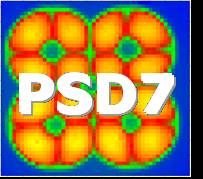Speaker
Dr
Serena Mattiazzo
(University of Padova, Dept. of Physics & INFN Padova)
Description
At the INFN Legnaro Laboratories (Padova, Italy) a new instrument
dedicated to the study of induced radiation damage in
microelectronics devices has been recently installed in the SIRAD
beam line, a facility devoted to heavy ion characterization of
microelectronics devices and materials. This new instrument consists
of an electronic microscope capable of recognizing with micrometric
resolution the impact point of every single ion onto the target.
The development of the readout system for this apparatus led to the
construction of two novels position detection systems: the first is
based on a classic PSD sensor; the second, more innovative, is
developed around a new design that employs linear CCDs to provide
superior performances.
After detection and amplification, the resulting signal coming from
the microscope is a sequence of light spots rapidly blinking on a
4cm diameter phosphor screen. The development of a device capable of
detecting the light spots with sufficient time resolution (at least
10,000 events per second) and enough spatial resolution (more than
400 linear point on the phosphor screen diameter) to not degrade the
intrinsic resolving power of the microscope was a challenging task.
The main issue when extracting the light signal from within the
vacuum chamber via an optical system is the relative low intensity
of the signal, as the efficiency of the optical system is not better
than 1%. This is the main difficulty when using commercial PSD.
Also, the need for a fine time correlation did not allow us to use a
classical square CCD to image the phosphor screen due to its low
frame rate and to the computational overhead in recognizing the
multiple signal spots present on every frame.
The first solution involved the development of a sensing system
starting from a commercial PSD, developing a dedicated, low noise
electronics. This system, based on a 2*2 cm2 two dimensional PSD is
currently operating, offering sufficient speed and resolution.
A novel solution was also investigated. Instead of using
traditional, charge splitting based PSD sensors, we developed a
system based on CCD devices. Commercial CCDs offer resolution and
sensitivity sufficient to fulfill our needs in terms of image
quality but, as said above, they are too slow: even the fastest 1
Megapixel CCD cannot handle more than a few tens of frames per
second. Moreover, the stream of data from a 1MPixels CCD running at
10 kiloframes per second would be not manageable by any reasonable
data analysis system.
We found a solution by coupling two linear CCDs (1000 pixels each)
in an orthogonal arrangement through a dedicated optical system. The
optical system made allowed each CCD to read just one dimension,
dramatically reducing the amount of data to acquire: to get the same
resolution (i.e. 1 Megapixel) we have to read just 1000 pixels
instead of the 1 million in a traditional square sensor. Moreover,
this solution greatly simplifies data analysis, as two separated
vectors have to be analyzed, instead of a single huge matrix. This
allows us to implement the entire analysis procedures at hardware
level, limiting the data bandwidth towards the DAQ computer to a
mere 200 kbyte/s when running at full speed.
We want to remark that this novel standalone system may be useful in
any situation where a fast high-resolution determination of the
position of a light spot is required. Also, a further development,
adopting state of the art sensors and electronics, could bring the
speed of such kind of device near 100k frames per second with an
equivalent resolution better than 10 Megapixel.
Primary author
Dr
D Bisello
(University of Padova, Dept. of Physics & INFN Padova)
Co-authors
Dr
Piero Giubilato
(University of Padova, Dept. of Physics & INFN Padova)
Dr
Serena Mattiazzo
(University of Padova, Dept. of Physics & INFN Padova)




